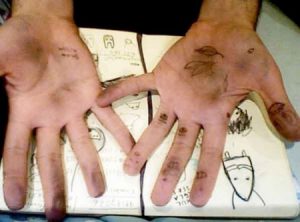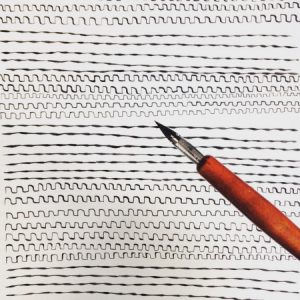Ink can be a messy medium!
Before you begin your work in this medium, here are some helpful tips and tricks.
- Always warm up.
Just as you would warm up before exercise, warm up before using ink. Take the time to work on your lines and strokes on a separate sheet of paper before you begin working on your actual illustration. This will ensure that you have proper command of your hands.
This image is of comic book artist Jacob Halton’s inking warm-up, which he does in the morning to “get command of his hands”.
Jacob Halton’s inking warm-up page
- Don’t tape down your page.
Marks are easier to make when moving your hand in certain directions, so move your page around in order to make this possible. Work your hands in the way that they move naturally.
- Begin with thicker lines.
This is a way to keep warming up your hands. Thicker lines are safer to work with until you feel confident enough to move onto the drawing’s fine detail portions.
- Work in a way that minimizes smearing.
Don’t try to work on the illustration in a left-to-right method, or in any order like that. Instead, think about where your hand may smear the ink, and work in a way that minimizes that smearing. Some artists place a piece of paper or paper towel under their inking hands in order to help with this process.
- Address large areas of ink last.
All paper, including watercolor paper or Bristol board, will warp when wet. It’s much easier to draw controlled lines on completely flat paper. Therefore, draw your lines before soaking any large areas with ink, otherwise known as executing an ink wash. Another method is to fill in large areas of ink, and then either allow for drying time or use a hair dryer before moving on to finer details.






Pingback: Reading on INKING | COMD 2313 Illustration 1, SP2018
I learn that it is easier to ink lines first before inking large areas of paper because of the folding caused by soaking the paper. That taping down the paper is not a good idea because “marks are easier to make when moving your hand in certain directions”. Also that its best to try and work in a way that avoids smears.
I learn that it is easier to ink lines first before inking large areas of paper because of the folding caused by soaking the paper. That taping down the paper is not a good idea because “marks are easier to make when moving your hand in certain directions”. Also that its best to try and work in a way that avoids smears.
I learned that it’s good to practice inking first rather than just starting to ink on a final drawing. When i start inking, I don’t want to mess up by not knowing what do. So it’s better to practice by inking freely before heading on to a final drawing
I learned that it’s good to practice inking first rather than just starting to ink on a final drawing. When i start inking, I don’t want to mess up by not knowing what do. So it’s better to practice by inking freely before heading on to a final drawing
Its always good to warm up every time before you do any serious inking and for first timers on inking start by making thick lines is easier than trying to make those thin lines as time goes on you will get used to it and it will come easier.
Practice. Practice. And more practice. It’s best to warm up your inking skills before transitioning to any ink drawing or piece. Various methods to avoid inking mistakes is to not tape down your page, moving the paper around in a way that makes inking more natural works best to prevent marks. Also work in a way that minimizes smearing, placing a paper towel under your inking hand helps a lot. And working with thicker lines will help boost your confidents and progression with inking.
I learned here that, just like painting/drawing with any other median, you need to warm up. In order to get your hand ready to ink accurately. What I also took from this is that you always, when warming up, need to begin with thicker lines, just to get the hand ready to draw more difficult and thinner lines as you go. One more thing I took out of this reading, not tapping down the paper you’re working on to ink with, you lose the freedom to move and adjust the paper to where you’re comfortable inking on.
Ive learned to always warm up first before doing any serious inking. Inking is very easy to mess up and you want to make sure you have a steady focused hand. That way you don’t have to trash a project if you make a mistake. Also make sure that you have the freedom to move your paper around to be more comfortable while you ink specific parts of your drawing.